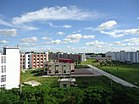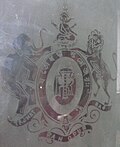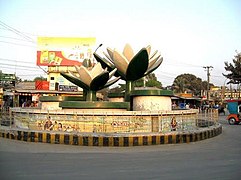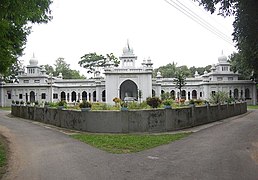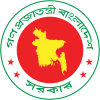
Dhaka, formerly known as Dacca, is the capital and largest city of Bangladesh. It is the ninth-largest and seventh-most densely populated city in the world. Dhaka is a megacity, and has a population of 10.2 million residents as of 2022, and a population of over 22.4 million residents in Dhaka Metropolitan Area. It is widely considered to be the most densely populated built-up urban area in the world. Dhaka is the most important cultural, economic, and scientific hub of Eastern South Asia, as well as a major Muslim-majority city. Dhaka ranks third in South Asia and 39th in the world in terms of GDP. Lying on the Ganges Delta, it is bounded by the Buriganga, Turag, Dhaleshwari and Shitalakshya rivers. Dhaka is also the largest Bengali-speaking city in the world.

Chittagong, officially Chattogram, is the second-largest city in Bangladesh. Home to the Port of Chittagong, it is the busiest port in Bangladesh and the Bay of Bengal. It is the administrative seat of an eponymous division and district. The city is located on the banks of the Karnaphuli River between the Chittagong Hill Tracts and the Bay of Bengal. The Greater Chittagong Area had a population of more than 5.2 million in 2022. In 2020, the city area had a population of more than 3.9 million. The city is home to many large local businesses and plays an important role in the Bangladeshi economy.

Dhaka Division is an administrative division within Bangladesh. Dhaka serves as the capital city of the Dhaka Division, the Dhaka District and Bangladesh. The division remains a population magnet, covers an area of 20,508.8 km2 with a population in excess of 44 million, It is the most populous country second level division of the world, growing at 1.94% rate since prior count, compared with national average of 1.22%. However, national figures may include data skewing expatriation of male labor force as gender ratio is skewed towards females.

Sylhet is a metropolitan city located in the northeastern region of Bangladesh. It is the administrative center of Sylhet Division. It is situated on the banks of the Surma River. The city has a population of approximately 700,000 people, making it the fifth-largest city in Bangladesh.

Rokeya Sakhawat Hossain, commonly known as Begum Rokeya, was a prominent Bengali feminist thinker, writer, educator and political activist from British India. She is widely regarded as a pioneer of women's liberation in India and Bangladesh.

Mymensingh District is a district in Mymensingh Division, Bangladesh, and is bordered on the north by Meghalaya, a state of India and the Garo Hills, on the south by Gazipur District, on the east by the districts of Netrokona and Kishoreganj, and on the west by the districts of Sherpur, Jamalpur and Tangail. Mymensingh is the 8th administrative divisional headquarter and 12th city corporation of Bangladesh. According to Ministry of Public Administration, Mymensingh is ranked 4th in district status. The density of Mymensingh city is 44,458/km2 which is the second most densely populated city in Bangladesh. Mymensingh attracts 25 percent of health tourists visiting Bangladesh. Once known as the largest district of the Indian subcontinent. Mymensingh town is the district headquarters.

Nilphamari district is a district in Northern Bangladesh. It is a part of the Rangpur Division. It is about 400 kilometers to the northwest of the capital Dhaka. It has an area of 1,580.85 square kilometres (610.37 sq mi). Nilphamari is bounded by Rangpur and Lalmonirhat in east, Rangpur and Dinajpur in south, Dinajpur and Panchagarh in west, Cooch Behar of India in north. The many rivers in Nilphamari district include the Tista, Buritista, Isamoti, Jamuneshwari, Dhum, Kumlai, Charalkata, Sorbomongola, Salki, Chikli, Chara and Deonai. There are four Municipal Corporation in Nilphamari district. Area of these Municipalities are Nilphamari 27.50 SqKm, Saidpur-34.42 SqKm, Jaldhaka-28.22 SqKm and Domar-9.421 SqKm. There are 60(sixty) Unions, 370 Moujas and 378 Village in Nilphamari district.

Rangpur is a district in Northern Bangladesh. It is a part of the Rangpur Division.
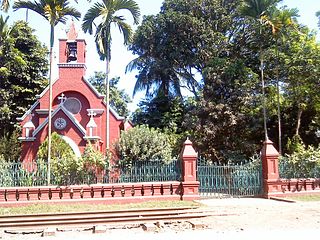
Saidpur is a city of Nilphamari district in Rangpur Division of Bangladesh. The city has become a very important communication hub for adjoining major district headquarters. Saidpur Airport is one of the domestic airports in Bangladesh. The Syedpur Railway Workshop, established in 1870, is the largest in Bangladesh and was the major railway workshop for Assam-Bengal railway. The city has historically been an Urdu-speaking community with close ties to Bihar.

Tajhat Palace is a historic palace of Bangladesh, located in Tajhat, Rangpur. This palace now holds the Rangpur museum. Tajhat Palace is situated six km. south-east of the city of Rangpur, on the outskirts of town.
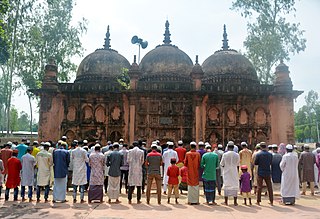
Mithapukur is an upazila of Rangpur District in the division of Rangpur, Bangladesh. The upazila is situated in the middle of Rangpur, surrounded by Rangpur Sadar to the north, Pirganj to the south, Badarganj and Phulbari to the west and Pirgachha and Sundarganj to the east. Mithapukur is famous for being the birthplace of Begum Rokeya and its sweet mango Harivanga.

Tourism in Bangladesh includes tourism to World Heritage Sites, historical monuments, resorts, beaches, picnic spots, forests, tribal people, and wildlife of various species. Activities for tourists include angling, water skiing, river cruising, hiking, rowing, yachting, and sea bathing.

The following outline is provided as an overview of and topical guide to Bangladesh:

The Begum Rokeya University, Rangpur, formerly Rangpur University, is a public research university in Rangpur, Bangladesh. Founded in 2008, it is the only general categorised university in Rangpur Division and the second public university in the region. It was named after the feminist writer and social worker Begum Rokeya. It is the 30th public university of Bangladesh.

Rangpur Division is one of the Divisions in Bangladesh. It was formed on 25 January 2010, as Bangladesh's 7th division. Before that, it was under Rajshahi Division. The Rangpur division consists of eight districts. There are 58 Upazilas or subdistricts under these eight districts. Rangpur is the northernmost division of Bangladesh and has a population of 17,610,956 in the 2022 Census.
Karimunnesa Khanam Chaudhurani was a Bengali poet, social worker, and patron of literature.

The Rangpur region predominantly includes the northern Bangladeshi districts of Rangpur, Gaibandha, Kurigram, Lalmonirhat and Nilphamari. Since 2010, Rangpur City has been the headquarters of the Rangpur Division of Bangladesh.
Md. Hasibur Rashid is a Bangladeshi educationist and professor in the Department of Management Information Systems, Dhaka University and Head of Department of MIS, Begum Rokeya University. He is the fifth Vice-Chancellor of Begum Rokeya University, Rangpur (BRUR). Prior to his appointment as Vice-Chancellor,and he was the second treasurer of the University.
Bangalipur Union is a Union Council under Saidpur Upazila of Nilphamari District, in the division of Rangpur in Bangladesh. It has a total area of 41.44 square kilometres and a population of 21,379.

The zamindars of Mahipur were a Bengali aristocratic family of feudal landowners. The zamindari estate encompassed the Chakla of Qazirhat under the Cooch Behar State since the Mughal period. Although their aristocratic status was lost with the East Bengal State Acquisition and Tenancy Act of 1950, the Mahipur estate remains an important part of the history of Rangpur and belongs to one of the eighteen ancient zamindar families of Rangpur. The zamindari palace was lost as a result of flooding from the Teesta River, although the mosque, cemetery, polished reservoir and large draw-well can still be seen today.





